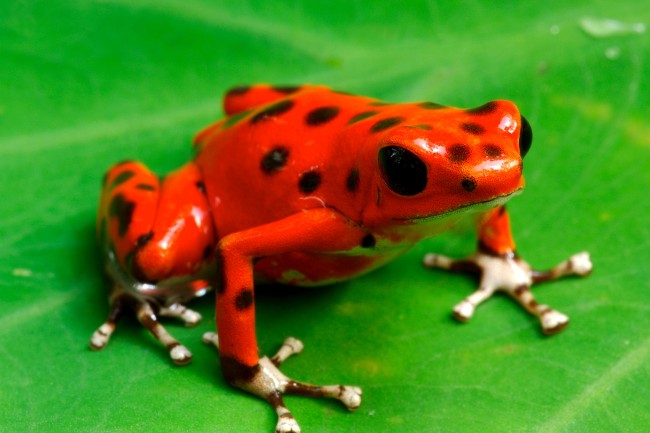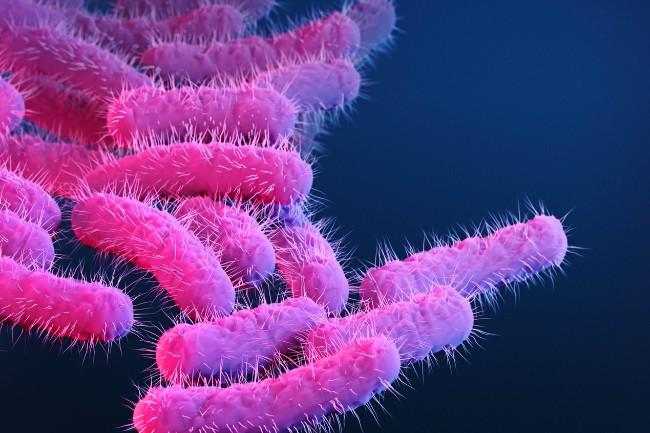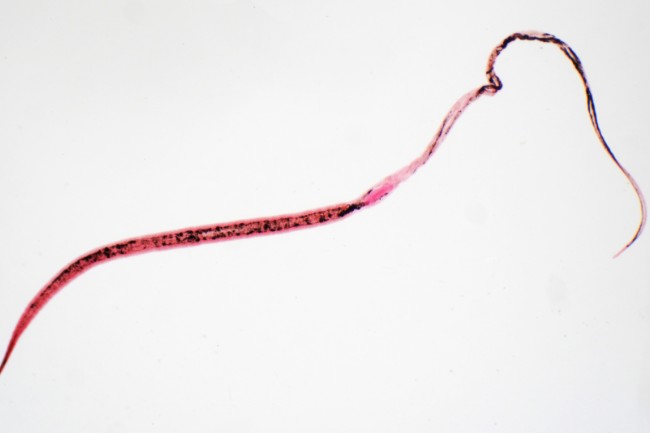Frogs can carry a large number of diseases, however, most are not transferable to humans.
The poorly frog
There are over 7,000 species of frogs across the world, making up over 80% of all known amphibians. What has made them so successful is that they are highly adaptable. Frogs have learnt to live in ponds, on land, in trees and even in deserts.
However, despite their adaptability frogs are facing an apocalypse. Over 200 species of frogs have gone extinct since the 1970s, and around a third are thought to be at risk of extinction. This is in part because frogs are surprisingly sensitive souls, reacting quickly to changes in their environment.
Amphibians, such as frogs, are often termed ‘indicator species’. Indicator species are species that increase or decrease rapidly when something changes within an ecosystem. This can help scientists monitoring an environment and notice that something positive or negative is occurring. For frogs, their rapid decline tends to show that their habitat is being polluted in some way.
The reason for their sensitivity may be their thin skin, which means they can easily absorb toxins into their bodies. While low levels of pollution may not always be enough to kill off our friendly frogs, it can weaken the population making more vulnerable to many of the froggy diseases that can decimate populations.

What illness can frogs have?
When it comes to how many frog diseases there are, the answer is we don’t know. Researchers in remote areas are constantly finding new and previously unknown species of frogs, and it’s likely there are many more to find. Without knowing what frogs are out there, it’s impossible for us to know all of their many diseases.
| Disease | Description | Transmission |
|---|---|---|
| Chytridiomycosis | Fungal disease that affects frog skin and can be deadly | Contact with contaminated water or infected frogs |
| Ranavirus | Viral infection causing severe illness and mortality in frogs | Direct contact with infected individuals or contaminated environments |
| Red-leg Syndrome | Bacterial infection characterized by red discoloration and swelling of the limbs | Contact with contaminated water or soil |
| Frog Virus 3 (FV3) | Highly contagious viral infection with various clinical signs | Direct contact with infected frogs or contaminated environments |
However, there are some diseases that are well studied, here are a few we are already aware of.
Viruses
Viruses are simple organisms, that contain DNA or RNA that replicates once it is inside other living creature. Viruses are very common in the natural world, and often specialise to particular species or groups of species. Rabies is an example of a virus that can affect humans.
Within frogs one group of viruses is particularly harmful, known as Ranavirus, with rana being the word for frog in latin. Thought to originate from viruses that infect fish, they are now a serious causer of frog declines across the globe.
Bacteria
Bacteria are largely free living single celled organisms that are thought to have been some of the earliest forms of life. While we tend to think of them in a negative context they are incredibly important for life on earth, helping to break down dead matter, fix nitrogen in the soil, and they even live symiotically within our bodies, helping us to break down our food, amongst other tasks.

Without bacteria it is doubtful we could have life on earth, as their roles are so important in order for other plants and animals to survive. However, while most bacteria as beneficial, there are some that have taken on a more harmful lifecycle. The bubonic plague is perhaps the most famous bacterial outbreak.
In frogs, bacteria have both a symbiotic and a harmful relationship. A common bacterial illness is dermatosepticemia or ‘red leg syndrome’. Red lesions appear on the frog’s legs or belly. Extreme cases can result in skin rot.
Fungi
We may think of fungi more in terms of toadstools and mushrooms, but molds and mildews are also types of fungi. Like bacteria, fungi have a vital role to play within the natural world in terms of decomposition and nutrient recycling.
Most fungi species are therefore beneficial, and a key part of many ecosystems, however, there are those that are damaging to certain species. In humans a common fungal infection is athlete’s foot.
Fungal infections are highly devastating to many frog populations, however they are also a very natural part of a frog’s environment, as they often live in damp habitats where fungi thrive.
Much of the devastation of frog species through fungal infections is down to populations having been previously stressed or weakened by pollution or other challenges such as climate change.
The chytrid fungus is a common amphibian fungus, which feeds on the skin of the animal. Many frog species periodically slough their skin, removing the top layer and regrowing a new skin, however, this can create a particularly vulnerable time for them, as the new skin is much thinner than the old skin.
In addition to this, many species will eat their old skin, which can lead to them ingesting fungal spores that may be harmful to them.
Protozoa
Like bacteria protozoa are also single celled, independently living organisms. What makes protozoa slightly different is additional complexities to their structure, such as a cell nucleus. These additions make them more similar to the cells of plants and animals than bacteria.
Protozoa are the hunters of the microbial world, feeding on bacteria and other microorganisms, as well as organic matter. Like bacteria they contribute to the release of nutrients that allows plants to thrive.
Similar to bacteria, there are many beneficial protozoa, but some are harmful or parasitic. Malaria is a famous example of a harmful protozoa.
In frogs, Severe Perkinsea infection (SPI) is a serious disease that results in the mass death of tadpoles. The protozoa, of the phylum Perkinsozoa, causes the tadpoles to float to the surface and be unable to dive. Eventually this leads to mortality.
Helminths
Helminths, or intestinal worms, are common in many frog species. Frogs can live with their parasitic worms without dying, however, those with high numbers of worms are likely to weight less or be smaller.
This is due to the fact that the worms are parasitic, feeding off their hosts. With more worms to feed, frogs are unlikely to get enough nutrition themselves, and this may eventually result in their deaths.

Ectoparasites
Unlike helminths, ectoparasites are external parasites, feeding on the outside of the host. This can include species such as ticks, fleas and mosquitos. It may seem a strange reversal of roles for these small animals to be feeding on frogs, rather than the frogs feeding on them, but the risk is clearly worth the reward.
One particularly horrifying species is the Toad-fly Lucilia bufonivora. The adult of this species lays its eggs on the backs of common toads, where they hatch and migrate into the nasal cavity of the frog. Here they will eat the toad from the inside out. A gruesome way to go.

Can humans catch diseases off frogs?
Reading through all the many diseases that frogs can carry it’s natural to worry that some of these might transfer to humans. The good news is it’s quite difficult for most diseases to migrate between species.
| Disease | Transmission Mode | Prevention |
|---|---|---|
| Salmonellosis | Direct contact with contaminated frog or water | Proper hygiene and handling practices, avoid contact with sick or wild frogs |
| Dermatitis | Skin irritation from contact with certain frog species or their secretions | Avoid handling frogs without protective measures, proper handwashing |
| Leptospirosis | Exposure to urine or contaminated water sources | Avoid contact with contaminated water, wear protective clothing/gloves |
| Mycobacteriosis | Handling infected frogs or contaminated water | Quarantine and testing, proper hygiene practices, avoid handling sick frogs |
Also read: Frogs & Their Teeth (Do They Bite & Does it Hurt?)
The exception to this can be if a frog is eaten. There are many species of frogs that have traditionally been eaten, particularly larger species such as the mountain chicken. As with all wild food there is a risk that any parasites or diseases the animal carries can be passed on to the human that eats it.
| Preventive Measure | Description | Implementation |
|---|---|---|
| Quarantine and Testing | Isolating and testing new frogs before introducing them to existing populations | Conduct thorough health checks and quarantine periods, diagnostic testing |
| Hygiene Practices | Proper handwashing and disinfection after handling frogs or their habitats | Use of soap or disinfectants, avoiding cross-contamination |
| Biosecurity Measures | Preventing cross-contamination between frog habitats and equipment | Strict protocols for cleaning and disinfection, separate tools and equipment |
| Environmental Management | Maintaining clean and suitable conditions for frogs to reduce disease risk | Proper water quality management, habitat maintenance |
There are a small number of diseases that can be transferred through contact, the most notable being salmonella. As with many viruses, bacteria or other diseases, simple hygiene rules can prevent their spread. Washing your hands after holding a frog can help prevent many illnesses.
However, overall, you’re much more likely to get ill from coming into contact from other humans, than from getting close and personal with a frog.

